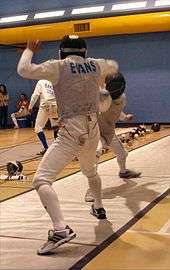Attack (fencing)


In fencing, an attack is "the extension of the arm towards the target". In order for an attack to be awarded successfully the fencer must accelerate their hand and feet towards the target. If the fencer does not accelerate the hand or foot this is a preparation.
Tactical significance
The purpose of an attack is either to make a hit or to provoke a defensive reaction. In order to do either, the attacker must create a realistic threat. A fencer launches an attack by extending his weapon-carrying arm in such a way that the point (in any weapon) threatens the opponent's target area (except in sabre where the blade need not be threatening the target when the arm is extended, the right of way can still be given). The attack may be delivered with the aid of appropriate fencing footwork.
In weapons governed by priority rules (foil and sabre), the attacker gets priority (as a reward for his initiative). He retains this priority until his attack either misses, runs out of momentum, or is parried.
According to the FIE rules, no footwork on its own can be called an attack, unless it is accompanied by an extending sword-arm.
Classification
- Simple attack: An attack executed in a single movement with no overt intention other than to hit the opponent. Simple attacks may be
- direct: the attackers point or edge proceeds in a straight line to the target;
- indirect: on its way to the target the attackers blade passes over or under the defender's.
- Compound attack: An attack which includes one or more feints designed to misdirect the opponent's defense. The final motion of a compound attack (which delivers the hit) is called a trompment. To retain priority throughout a compound attack, the attacker must avoid breaking time (see below) or letting his opponent find the blade.
- Breaking time: Drawing the arm back at the end of a feint (either to avoid a parry or to preserve balance). The attacker's priority is based on the creation of a continuous threat. Retraction of the arm corresponds to a receding threat and, consequently, to loss of priority.
- Attack by prise de fer: the attacker establishes contact with his opponent's blade and maintains control over it, until he makes a hit (if it is a simple attack), or until the opponent commits to a parry (if it is a feint).
- Feint (or second intention) attack: An action which has all the attributes of a real attack (either simple or compound) apart from the intention of hitting the opponent. Feint attacks aim to provoke a specific reaction (such as a parry-riposte or a counterattack), which the attacker can then counteract to his own advantage (to keep with earlier examples, through a planned counter-riposte or counter-time respectively). In other words, one does not attack with the first movement(s) or intention, but, rather, attacks with a second intention, the goal of which is to provoke a specific reaction from the open end. It is analogous to counter-punching in boxing or martial arts.
- Stop Thrust or Stop Cut: An attack by thrusting or cutting into an open end's attack that is done during the open end's preparation, prior to them establishing right of way in foil or saber, or executing a quick one-tempo attack in épée.
Any attack may be prepared by footwork (e.g. a step forward to bring you within range) or by bladework (e.g. a beat intended to upset your opponent's control over his weapon, draw a convenient reaction or confuse him into inactivity). Most elite fencers do not attempt to simply overpower their opponents with speed, but rely on the guile of the second intention to manipulate their opponents, thereby controlling them.
A direct thrust is sometimes known as "foining". (Middle English foinen, from foin, a thrust, from Old French foine, pitchfork, from Latin fuscina, three-pronged fish spear.)